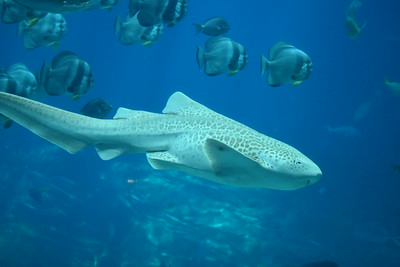
Sea Wonder: Zebra Shark

Photo credit: Laura Wolf
Z is for zebra shark (Stegostoma tigrinum), a long, sleek species of shark that is born with stripes that turn into spots as they age. In some areas, these sharks are called leopard sharks due to their spots, which can be confusing because there is also another species of shark that lives in the Pacific North American Coast with this moniker.
Description
Zebra sharks are long and sleek, reaching lengths of nearly 12 feet when fully grown, with their tails making up nearly half of their body length. They have small barbels (whisker-like sensory organs near their snouts, a small mouth with small teeth that are regularly replaced, and tiny eyes. When they are born, they are covered in yellowish stripes that are eventually replaced with brown spots that resemble those of a leopard when they reach maturity. Their long tails resemble a knife blade but these sharks are quite docile and can even act skittish around divers.
Diet and Habitat
Zebra sharks are nocturnal foragers that rely on small fish, snails, sea urchins, crabs, and other small invertebrates for their dietary needs. To find their prey, which are often on the seafloor or buried in the sand, they rely on their barbels to help them detect their target’s movements. With their small mouths and powerful gill muscles, zebra sharks easily vacuum up their prey in a single gulp. Their flexible bodies allow them to bend and fit into tight spaces where small fish might hide.
Zebra sharks are primarily found in the Indo-Pacific region of the global ocean and live along coral reefs where food is usually plentiful and conditions are just right. They have been observed at depths of about 180 feet and they often stay close to their home reefs. In the National Marine Sanctuary System, zebra sharks live near the National Marine Sanctuary of American Samoa and Rose Atoll Marine National Monument. Since they are most active at night, zebra sharks spend the daytime hours resting on the ocean floor and facing the ocean current so they can move water across their gills and continue breathing while remaining almost completely still.
Life History
Zebra sharks can live to be between 25 and 30 years, reaching maturity when they are fully grown, which is usually somewhere between five and 12 years of age. To mate, males attract females by biting their tail fins. If a male is successful, he is allowed to mate, which occurs internally by transferring sperm to the womb via claspers, which are modified pelvic fins. Females can lay up to four fertilized eggs at a time, which attach to the sea floor using fine fibers on their outer coating. Eggs incubate and embryos develop for between six and seven months, hatching when environmental conditions are just right. Zebra shark pups are less than one foot in length when they hatch, growing quickly over the next few years into adulthood. Adult zebra sharks lead generally solitary lives, gathering in groups of between 20 and 50 individuals a few times per year for mating and foraging behaviors. Unlike other species of shark, zebra sharks can reproduce any time of year.
Threats and Conservation
Zebra sharks have few natural predators, most of which are larger shark species that catch a zebra shark on rare occasions, usually when other prey sources are scarce. The greatest threat to zebra sharks, then, are people. Zebra sharks are caught for their meat – which can be eaten fresh or dried – and their fins, which can be used in shark fin soup or in traditional medicines. In 2000, the United States passed a law that forbids shark finning and possessing shark fins without the rest of the animal’s body, and that prohibits foreign fishing vessels from shark finning in the US’ exclusive economic zone, waters that extend 200 nautical miles off the nation’s coasts. Nations like Canada, Mexico, Australia, and New Zealand manage shark fisheries, but it will take many more to ensure shark populations worldwide are healthy and can navigate survival pressures now and in the future.
Other threats to the species include climate change, ocean acidification, coastal development, physical and chemical pollution, and reductions in prey availability.
